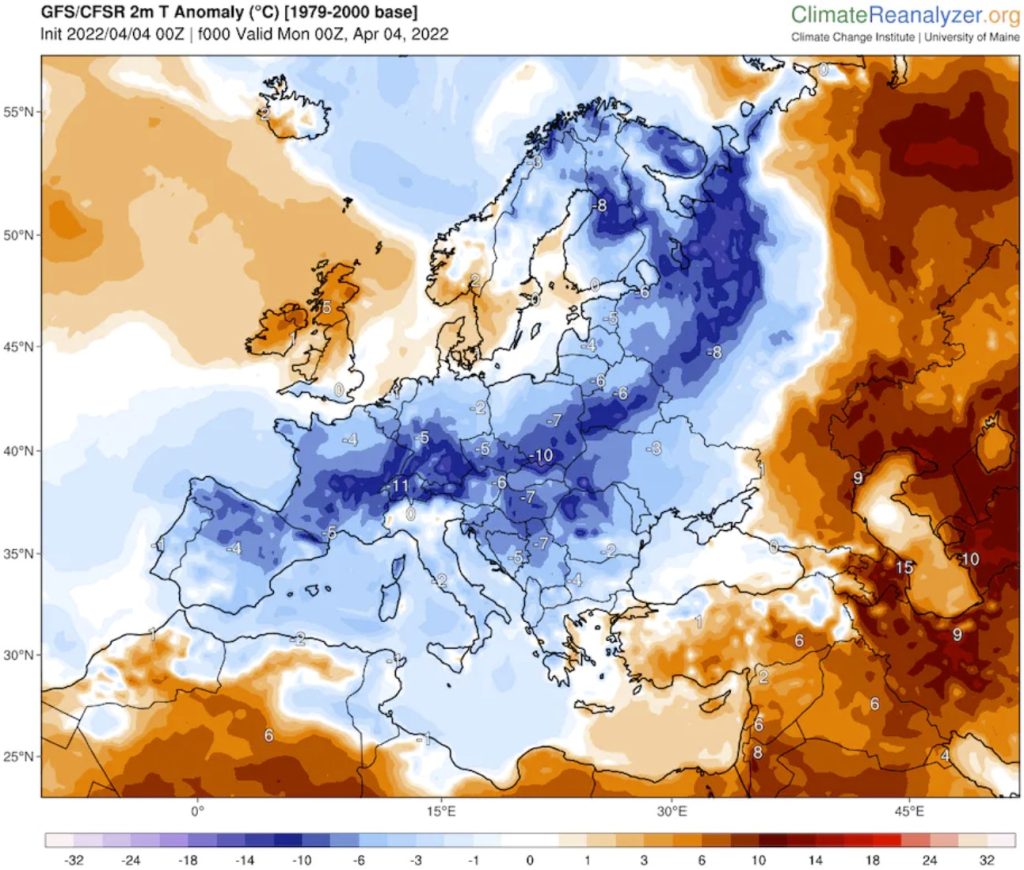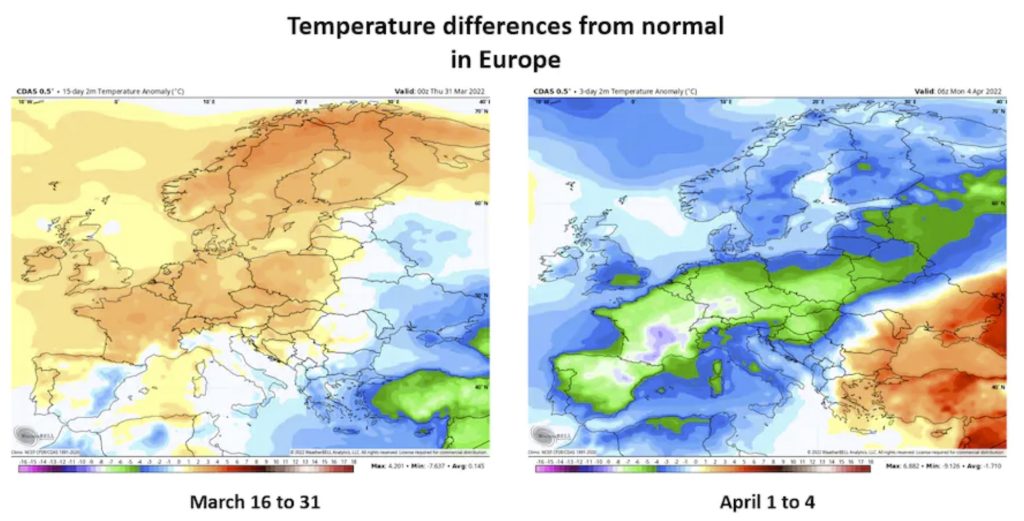
A historically intense April cold snap has descended on Europe, with temperatures plummeting to 20 to 30 degrees (11 to 18 degrees Celsius) below normal. The record-breaking cold has triggered harsh frosts, shocking early-blooming plants and crops in several countries.
The unseasonably cold weather, which arrived over the weekend, follows warmer-than-normal temperatures in previous weeks that caused a rapid greening of flora — particularly in France’s agricultural regions.
“It’s still difficult to evaluate the [damage] caused by the frost, but orchards (‘stone fruits’ such as plum trees, apricot, cherry) and vineyards have been impacted,” Jean-Marc Touzard, director of research at the French National Research Institute for Agriculture, Food and Environment (INRAE), said in an email.
Preparedness: Protect your home and car with the best lightning and EMP protection available…
Climate scientists are concerned that warming late-winter and early-spring temperatures are increasing the frequency of “false springs,” which spur earlier vegetation green-up before the threat has passed of frigid temperatures that can wipe out young, vulnerable plants.
Météo-France, the country’s weather forecasting agency, tweeted that France had its coldest April morning on record Monday (dating to 1947), with national minimum temperatures of 29.3 degrees (minus-1.5 Celsius).
??️ Il n’avait jamais fait aussi froid, une nuit d’avril, à l’échelle ??, depuis 1947 (création indicateur thermique national).
?Avec un indicateur thermique national de T°C MINI de -1.5 °C, cette nuit est la + froide.
12 avril 1986 (-1.4 °C).?Birkenwald (67), @SabineL67 pic.twitter.com/0vN72hMLkf
— Météo-France (@meteofrance) April 4, 2022
In the mountains, it was as cold as minus-6.7 degrees (minus-21.5 Celsius), an April record.
?L’indicateur thermique national affiche seulement 4.25°C du 1 au 3 avril 2022.
Il s’agit des 3 premiers jours d’avril les + froids observés en France depuis au moins 1930 (devant les 4.9°C des 1-3 avril 1955 et 1-3 avril 1970).
Graphique @infoclimat pic.twitter.com/RCfSlrifN5
— Guillaume Séchet (@Meteovilles) April 3, 2022
Guillaume Séchet, a French meteorologist, tweeted that April 1 to 3 were the coldest first three days of April in the country since at least 1930.
? Historic #cold for April in #France!
-21.5°C Les Pontets [1,008 m] ➡️ national April record at this elevation!
-20.4°C La Chaux [880 m]
-11.1°C Etalans [540 m]*
-9.3°C Mourmelon-le-Grand [115 m]*
*The national April record below 500 m is -10.5°C.See attached monthly records. pic.twitter.com/dn38YAskdF
— Thierry Goose (@ThierryGooseBC) April 4, 2022
Maximiliano Herrera, a climatologist who tracks international weather extremes, tweeted that freezing temperatures and record cold also were observed in Germany, Spain:
European Cold Spell: More heavy frosts also in Germany with few more long term stations which broke their April records of low temperatures:
-8.8C Memmingen
-8.1C Augsburg
-5.9C Wutöschingen-Ofteringen
-5.6C Emmendingen-MundingenIn Spain April record cold at Segovia with -5.6C pic.twitter.com/FmkCYXsv7p
— Extreme Temperatures Around The World (@extremetemps) April 4, 2022
And Austria:
Very cold tonight also in #Austria with heavy frosts after the snowfalls (including in the capital Vienna).
April monthly records were broken at Reichenau with -10.1C (POR since 1972) and at Freistadt (POR 1936-) . https://t.co/4Ogb9mMl82— Extreme Temperatures Around The World (@extremetemps) April 4, 2022
Weather maps showed a sprawling region of unseasonably cold conditions from Portugal to western Russia. The biggest temperature differences from normal were centered between Spain and Germany, with France hit hardest.
Preparedness: Use this filter to drink clean water at home!
Warm winter conditions probably made crops more vulnerable to frost. In Germany, winter was warmer than normal and recorded nearly 20 more frost-free days than in an average year. According to the European Commission’s monthly crop monitoring bulletin, “Frost tolerance is rather weak, making crops susceptible to freezing temperatures” in Germany.
In France, winter was around 1.8 degrees Fahrenheit (1 degree Celsius) above normal from February to mid-March.

Serge Zaka, an expert in climate and agriculture in France, said in a Twitter thread that the recent freezing weather is very damaging and the situation could lead to a national agriculture devastation similar to 1991 and 2021.
[Thread] La situation agroclimatique prévue pour la nuit à venir est dramatique avec une perte de >50% sur la moitié du territoire (s’accumulant aux pertes des jours précédents).
A priori, il s’agirait de nouveau d’une catastrophe agricole nationale tout comme en 1991 et 2021. pic.twitter.com/y4SwaY7yGF— Dr. Serge Zaka (Dr. Zarge) (@SergeZaka) April 3, 2022
A second straight false spring in Europe
It’s the second straight year that a harsh cold spell has arrived after an unusually early spring bloom. Last year, parts of Europe experienced their warmest March on record before record cold arrived in early April. Switzerland and Slovenia registered record April low temperatures. Many locations in France and Italy endured their coldest April weather on record.
The April cold snap in 2021 was devastating for French winegrowers, leading to $2.4 billion in damage, according to the Associated Press. Some vineyards lost 80 percent of their grapes.
However, the effects of the current cold wave in France may be less severe than in 2021 because of the timing and coverage, Touzard said. This year, the cold spell occurred a few days earlier, and vegetation growth, especially for vines, was less advanced. Many buds are still not open. The cold wave also seems to be less extensive, concentrated mainly in southwestern regions.
He also said winegrowers learned from last year’s devastating freeze. Now they have better monitoring of the frostiest plots, and they pruned their vineyards later and put up more protection. Some French vintners are lighting large candles or using sprinklers to thaw grapevines.
“The fruit tree growers and grape vine growers are … afraid of this kind of damage. It’s starting to be quite regular,” said Guillaume Charrier, also a researcher at INRAE. “It was about four times, maybe in the last five years or so” near the Rhone River in eastern France and near Bourdeaux.
“It’s part of the normal agricultural life to have frost events, but also we have the abnormal warmer winter temperature that increases the vulnerability of plants,” Charrier said.
False springs have caused agricultural damage not only in Europe in recent years, but also in several parts of the United States.
“If those flower buds get hit by frost, they don’t regenerate that spring, and they don’t regenerate for the whole year,” Theresa Crimmins, director of the USA National Phenology Network and a research professor at the University of Arizona, told The Washington Post in December. “There’s been in recent years some really devastating impacts where we’ve had early warmth, followed by frosts and then total loss of crops.”
A false spring in March 2012 was followed by an April freeze that resulted in a half-billion dollars in damage in Michigan. A false spring in 2017 and ensuing early-April frost resulted in $2 billion in economic damage in the Southeast.
Spring of 2012 was earliest on record, too early?
A 2019 study of how spring frost damage to trees may change in Europe as the climate warms found that some sensitive species “will paradoxically experience more frost damage in the future warming climate.”
Cold in Europe, but unusually warm surrounding it
The record-breaking cold in Europe in no way refutes the planet’s long-term warming trend. While it has been frigid in Europe, abnormally mild air has covered much of Asia and large parts of the North Atlantic.
Herrera tweeted that an “extraordinary heat wave is kicking off in Central Asia.” In Turkmenistan, it was 101.7 degrees (38.7 Celsius) on Monday.
An extraordinary heat wave is kicking off in Central Asia. After the 31.5C yesterday in Azerbaijan, today 4 April there were the following extremes:
Turkmenistan 38.7C
Uzbekistan 34.3C
Tajikistan 34.0C (at 750m !)
Kazakhstan 31.5C
The extreme heat will go on for several days. pic.twitter.com/NlprbBFhJo— Extreme Temperatures Around The World (@extremetemps) April 4, 2022
It’s cold, then warm… Everything is a cycle… And this month, we will get another salty electricity and energy bill… Always be prepared for the worst! [WP]
StrangeSounds.org has been banned from AD NETWORKS! You can support me here…
The following links feature products I recommend you to add to your preparedness plan to help you and protect you during an emergency:
- Protect your home and car with the best lightning and EMP protection available…
- Get a satellite phone to communicate with your loved ones when internet and phones are down…
- According to a new report, about 50% of world’s water is ‘too polluted’ for swimming, fishing or drinking. Use this filter to drink clean water at home!
- Qfiles is another great site for alternative news and information…














But, cooling means it’s warming. And, men can have babies, And, we evolved from aquatic life. Do it fer democracy! Babies are not human till I say they are. Tee hee hee…………jk
These are normal conditions where I live.
Solution plant trees that are more cold hardy if you have to replace them.Plant veggies later or be prepared to replant.use clothes tunnels.
They’re trying desperately to blame this on global warming when it was a late cold snap that did the damage, not an early spring. Those plants are growing normally for this time of year.
Operation indigo skyfold! Haarp weather modification
Haarp!!!!!wakeup!gmo look it up!
Haarp and GMO are two different things. Not every weather event is Haarp. The earth has gone through many life changing climate events in the past. They know we are going through another life changing climate event. They are using it to gain control over us through GW. Also they can prepare for it while we all die blaming each other. Was the last ice age Haarp?……..no it was not. You can blame the sun. ; )